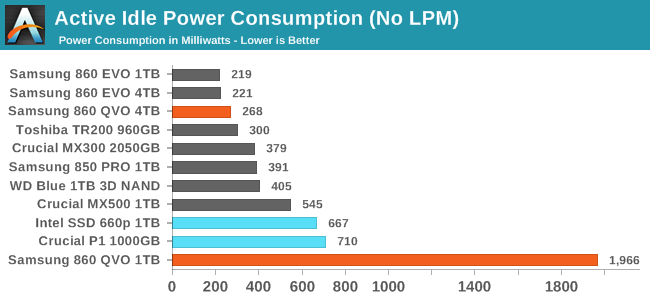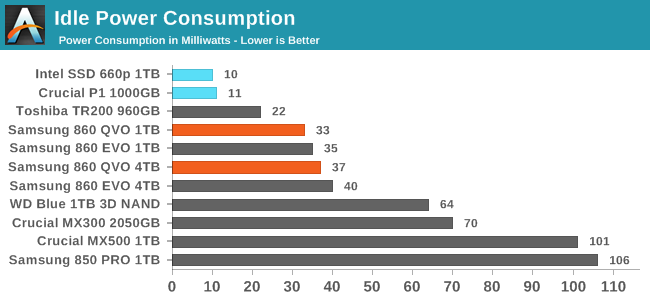The Samsung 860 QVO (1TB, 4TB) SSD Review: First Consumer SATA QLC
by Billy Tallis on November 27, 2018 11:20 AM ESTIdle Power Measurement
SATA SSDs are tested with SATA link power management disabled to measure their active idle power draw, and with it enabled for the deeper idle power consumption score and the idle wake-up latency test. Our testbed, like any ordinary desktop system, cannot trigger the deepest DevSleep idle state.
Idle power management for NVMe SSDs is far more complicated than for SATA SSDs. NVMe SSDs can support several different idle power states, and through the Autonomous Power State Transition (APST) feature the operating system can set a drive's policy for when to drop down to a lower power state. There is typically a tradeoff in that lower-power states take longer to enter and wake up from, so the choice about what power states to use may differ for desktop and notebooks.
We report two idle power measurements. Active idle is representative of a typical desktop, where none of the advanced PCIe link or NVMe power saving features are enabled and the drive is immediately ready to process new commands. The idle power consumption metric is measured with PCIe Active State Power Management L1.2 state enabled and NVMe APST enabled if supported.


It appears that the 1TB Samsung 860 QVO was still busy with background processing several minutes after the test data was written to the drive, so our automated idle power measurement caught it still drawing 2W. The 4TB was much quicker to flush its SLC cache and turned in a respectable active idle power consumption score. Both drives have good idle power consumption when put into the slumber state, though we've measured slightly higher than the official spec of 30mW.

The wake-up latency for the 860 QVO is the same as their other SATA SSDs, hovering around a reasonable 1.2 ms. It's not the best that can be achieved over SATA, but it's nothing to complain about.










109 Comments
View All Comments
stanleyipkiss - Tuesday, November 27, 2018 - link
Sell me a 8 TB QLC SSD for $400 and I'll bite. That's what QLC is for: moving off of spinning rust and onto SSDs with my bulk storage. Until then, this is useless without MASSIVE price drops. They are trying to milk saps who can't tell the difference between SSDs (i.e. normal consumers) by not dropping prices... yet.The race to the bottom for SSDs is coming. The manufacturers are just greedy enough not to want it to happen too soon.
But give me an 8TB or bigger SSD for $400 and I'll be the first to buy it. I'll even buy two!
R0H1T - Tuesday, November 27, 2018 - link
Yeah no one's selling you 8TB for $400 anytime soon. Aside from the fact that the R&D costs for QLC need to be recuperated first & companies need to reinvest an increasing amount for future development, there's also a point after which it doesn't make sense for the SSD, or NAND, maker to sell these at a loss.If you really want something that big, for dirt cheap, try spinners instead.
shabby - Tuesday, November 27, 2018 - link
How will they recoup the price when no one is going to buy this? The evo 860 is cheaper.R0H1T - Tuesday, November 27, 2018 - link
So you think the 860 QVO will stay at 15c/GB for the rest of it's time on the market or have you not seen high prices at launch, for any other product before this?shabby - Tuesday, November 27, 2018 - link
Obviously no, but why launch it at this price from the start. Should of launched it at $99 for 1tb that would probably get it some fanfare.R0H1T - Tuesday, November 27, 2018 - link
Early adopter tax? Samsung is usually the first to launch "one of a kind" products in the retail market & they get the ball rolling for many of the innovations in this industry. The prices would come down sooner if the competitors launch their SATA QLC drives quickly.shabby - Tuesday, November 27, 2018 - link
I doubt anyone will be rushing to the store to buy these.Ironchef3500 - Wednesday, November 28, 2018 - link
+1Jad77 - Wednesday, November 28, 2018 - link
"I doubt anyone will be rushing to the store to buy these."That is the perfect one-line review!
moozooh - Tuesday, November 27, 2018 - link
Yeah, the problem here is that the QVO is not a "one of a kind product"—in every possible aspect and scenario it's either the same as the EVO or worse, sometimes very substantially so, without being substantially cheaper. Right now there is exactly zero reason to choose it over the EVO. In order to compete with it favorably the QVO needs to be at least 25% cheaper to offset the disadvantages. In other words, under 11 c/GB. Until then nobody would be willing to give this inferior product the time of the day.